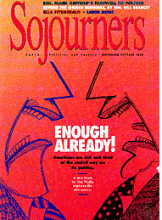A visit to the United Nations stimulates reflections and emotions regarding humanity's striving for community. Approaching the U.N. complex from 46th Street and First Avenue, you see the flags of the 185 member nations flying at the same height, placed in the alphabetical order of their country's names. The sight speaks of equality—the Stars and Stripes of the world's superpower is number 175 in this even row of national banners.
Stepping from the sidewalk onto U.N. property, you learn that technically you have left the United States and now stand on international soil. The scene around you changes dramatically (or is this one's imagination?). It seems that most of those entering the U.N. building are people of color, a visual reminder of global population realities. Clearly the human community comes in all shades of black, brown, yellow, and white.
A guided tour of the United Nations calls to mind the significant moments in humanity's quest for community as represented in the 51-year history of this organization. From the dark days of World War II, when the Allied nations foresaw international collaboration in the service of peace, to the actual Charter of the United Nations and its ratification in the spring and fall of 1945, to the first General Assembly of the then-51 member states in January 1946, you get a sense of early gropings toward the "one world" that those pioneers envisioned.
The list of secretaries-general recalls the names that have become identified with the innumerable issues, dialogues, dramatics, and sheer boredom that have characterized this five-decade pursuit of a truly global community: Trygve Lie (Norway), Dag Hammarskjold (Sweden), U Thant (Burma), Kurt Waldheim (Austria), Javier Perez de Cuellar (Peru), and Boutros Boutros-Ghali (Egypt). Each name speaks eloquently of humanity's yearning that "all may be one."
Read the Full Article
